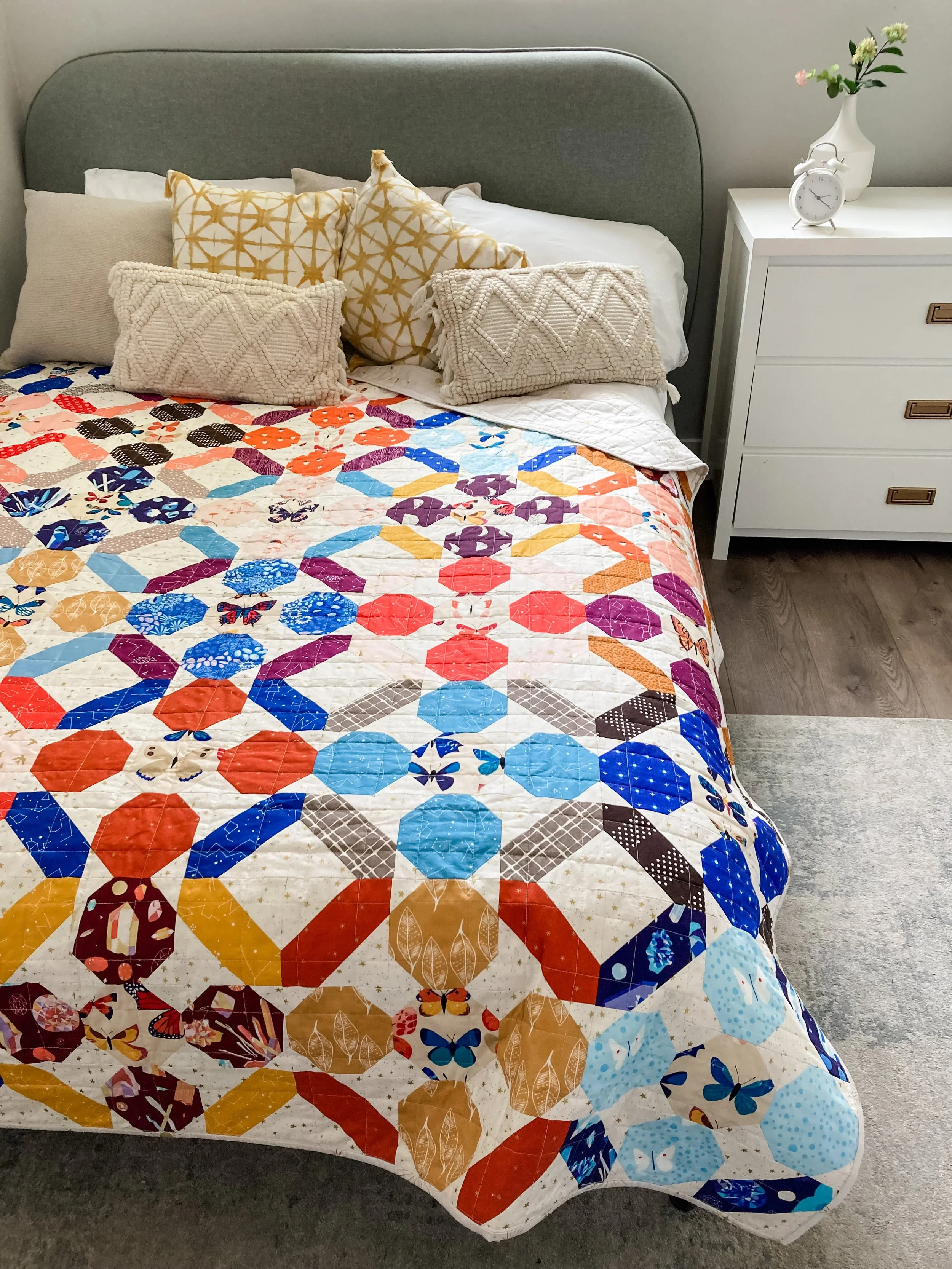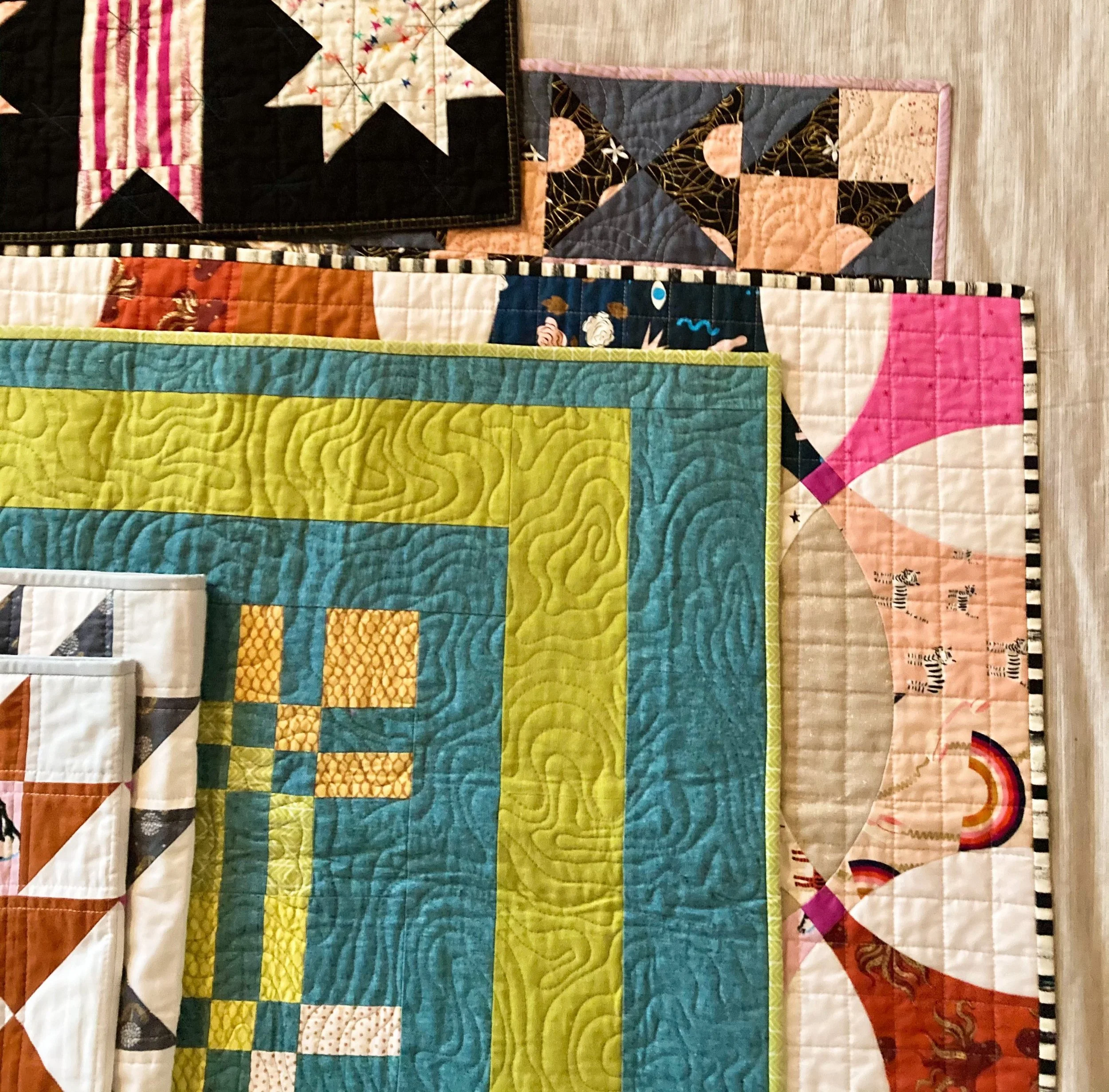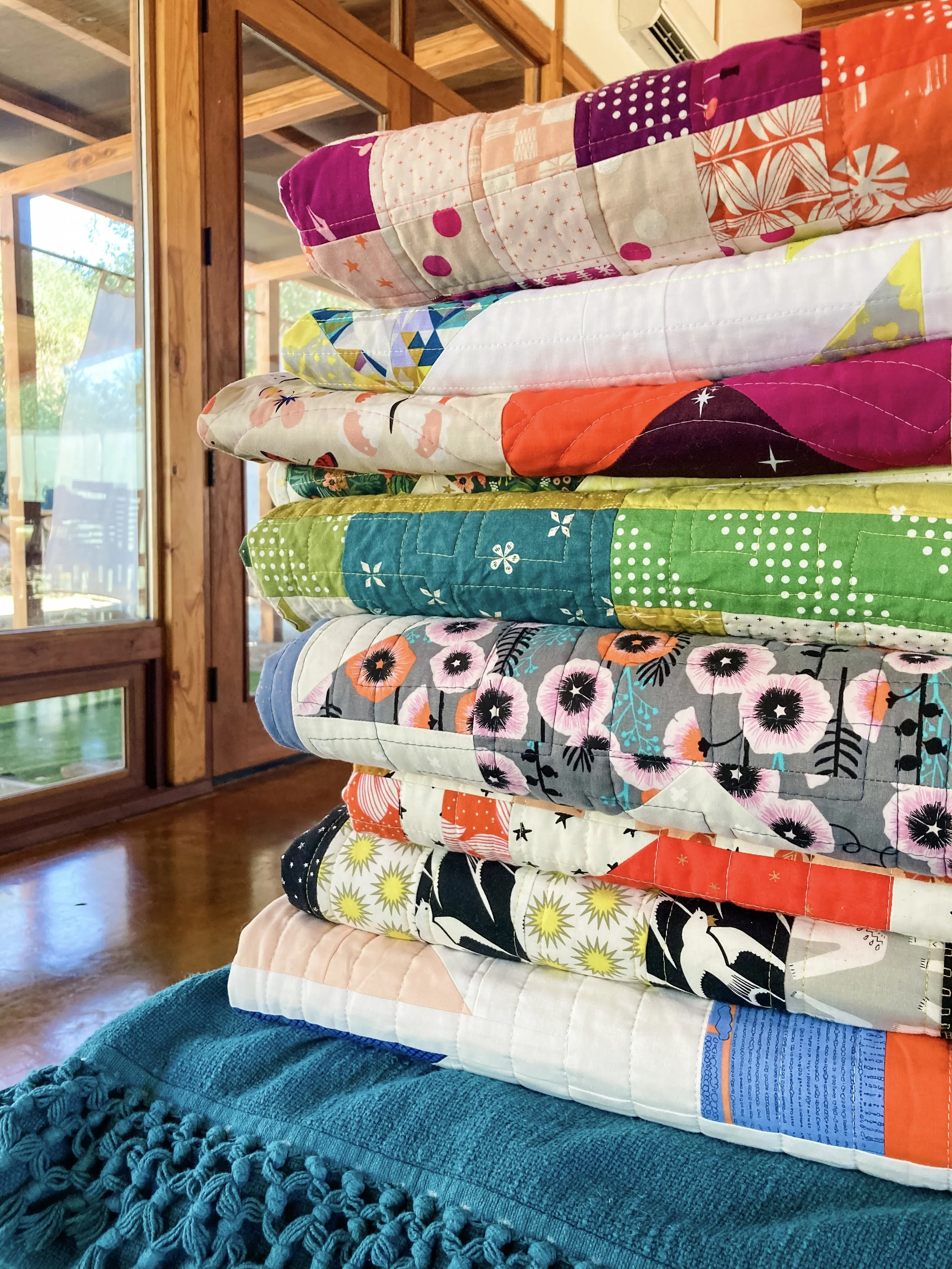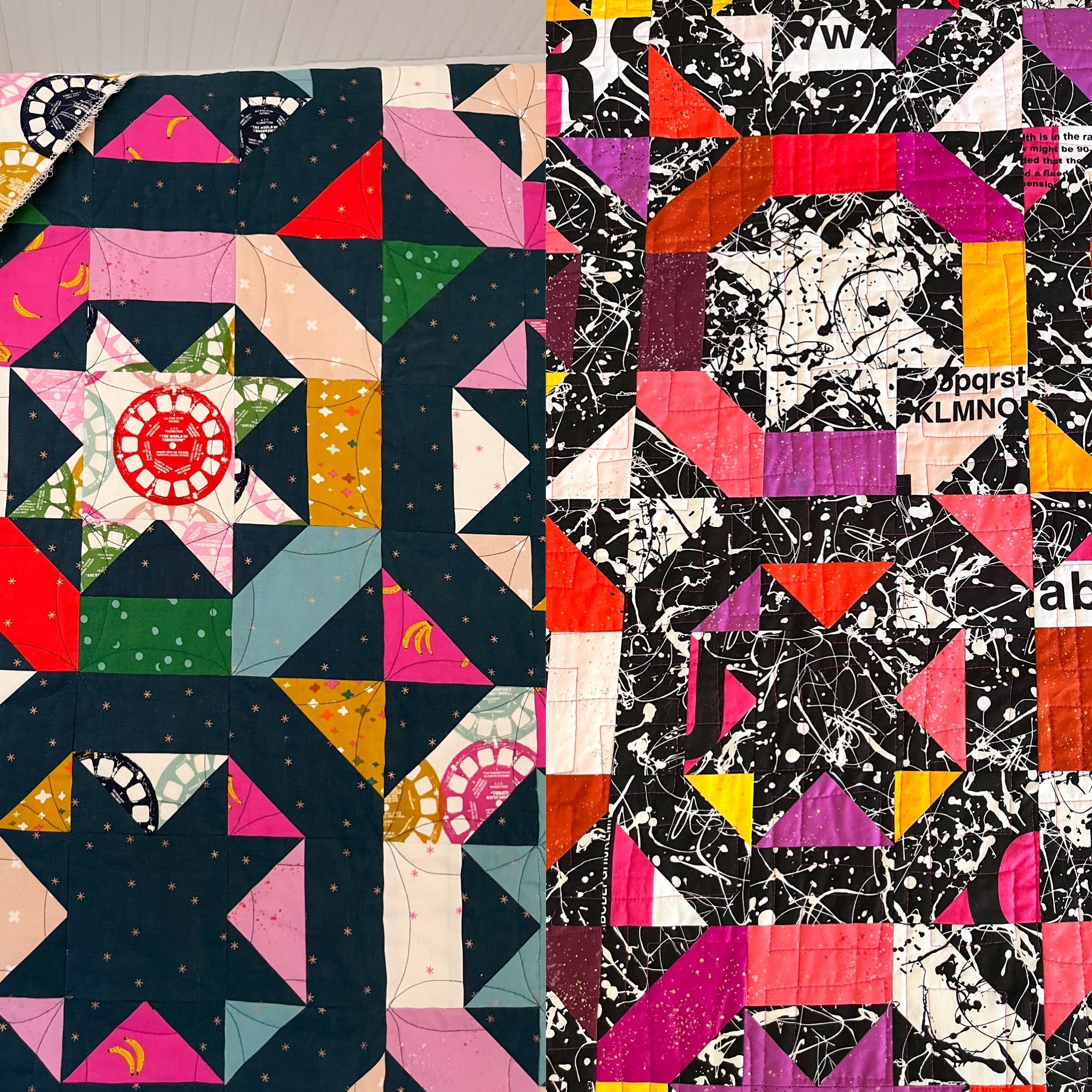Dorm Bedding Guide: Why Quilts WIN over Comforters
Never boring, never basic
Quilts vs Comforters: Why Quilts are the Ultimate Winners for Dorm Life
Graduation season is heating up! Which means that college dormitory move-in season is right there on the horizon. Dorm life comes with tight quarters, unpredictable temperatures, and shared laundry rooms, so when it comes to bedding, every choice counts. While comforters and duvets are often the default (partly due to confusion about what Twin XL might mean, cue eye roll), a handmade quilt actually can be the smarter, more stylish option for college students.
In a take that will surprise NO ONE, I will share why quilts are infinitely better suited for the college years and dorm life, from their easy-care design to their custom style potential, and how to pick one that will make any space feel more like home.
Size: What does Twin XL even mean?
Because it feels like Twin XL mattresses were invented just to confuse us and create a market for cheap jersey sheets that will last exactly four years (if you’re lucky!), let’s address dorm bed sizes straight out the gate.
Twin mattresses are 38 inches wide by 75 inches long. Twin XL mattresses, found in many college and boarding school dorm rooms, are 38 inches wide by 80 inches long. Yes, that is correct, the only difference between the two is that a Twin XL mattress is 5 inches longer. One hand’s width of difference necessitates an entirely new set of sheets. But what about the bed cover (comforter, duvet, or quilt)?
The twin XL bed was designed to squeeze into a small dorm room while still comfortably accommodating as many body heights as possible. They might be commercially available for use in regular homes, but as a short person, I have honestly never looked into it.
So think about that, a hand’s width of extra length. If your bed covering is 80 inches long, it would cover a twin mattress from top to bottom, with 5 extra inches draping off the bottom. It would cover a twin XL mattress from top to bottom, with no drape. If you leave your pillows uncovered, that same bedding will cover a twin XL mattress from just below your pillow with about 10 extra inches draping off the bottom.
This Butterfly Knuffel quilt is approx. 66” x 80” and is seen here on a full bed (same length as a regular twin), with plenty of drape on the end
You can think about the width the same way. Both twin and twin xl mattresses are 38 inches wide, so if your comforter or quilt is about 70 inches wide (fairly standard), it will drape about 15 inches off each side, or 30 inches off one side (if it’s up against a wall, for example).
So when deciding if a comforter or quilt will fit your dorm bed, you should consider if you want extra draping off the bottom of the bed, or the sides, if the bed will be pushed up against a wall, or if you’re particularly tall. Whether it’s labeled “twin” or “twin xl” is not as important as your particular needs.
My semi-custom quilts, for example, are typically made in a small twin size, about 65” x 80” (all of the ‘Road Trip’ quilts pictured above are this size). This is a great size for a dorm bed, and a less expensive option for a customized quilt, which I explain more in this post. If your bed is pushed up against a wall, you still have quite a lot of drape down one side, and it covers an entire bed without much drape at the end, since your bed might abut another piece of furniture or be up against another wall.
However, if you’re on the taller end of the spectrum, or you’d prefer a lot of drape on the bottom end of your bed, you would want to choose a cover that’s at least 90 inches long, if not longer.
Approximately 70” x 94”, the Retro Strawberries quilt comfortably fits a Twin XL bed for a tall person, with plenty of drape all over.
If your dorm bed is on risers (bed stilts that expand your underbed storage), you could even go with a double/full bed covering, to drape over the sides and cover up the underbed area. But I think a bed skirt would be a more manageable option for that purpose, as the weight of a wide comforter or quilt might drag your covers to the floor while you’re trying to sleep.
Or, if you know you will only spend 2 years or so in that Twin XL bed before you strike out on your own for a place with a more spacious bed, a full or queen quilt might be a better investment to begin with. You will have extra drape on your dorm bed, but you will be all set once you move onto bigger and cozier horizons.
AT 76” x 80” the Ember quilt would have a lot of extra drape on the sides, until it was on a double/full bed, where it would fit perfectly.
Quilts are Lighter, Made of Natural Fibers, and Easier to Wash
Comforters are often filled with polyfil (polyester fiberfill), a polyester batting solution that makes them puffy and warm. Some might say too warm. Polyester is a synthetic material so it doesn’t breathe as well as natural fibers like cotton and bamboo. If you run hot while you sleep, or you are prone to sweating, you will want to look for natural fibers.
This synthetic fiberfill is also a bit of a pain to wash. Some people might prefer the way a high-loft comforter looks puffy on their bed. But that same high-loft puff can be a pain to wrestle into a shared washing machine come laundry day. And it might cost you an additional cycle in the dryer to get completely dry. In my college dorms, an extra dryer cycle meant an extra 4 quarters, and an extra hour of monitoring the machine to make sure nobody made off with your fresh bedding.
Most of the quilts I make (unless specially ordered with custom materials) use natural fibers, namely cotton fabric and bamboo batting. This gives them a low loft (flatter appearance than a comforter) drape, and they take up much less room in your washing machine. I find that a quilt gets completely dry in a single cycle in my dryer. This is a boring point in quilts’ favor, but absolutely crucial in a shared laundry room situation.
Some people solve this problem by going with the comforter’s modular cousin: the duvet. A duvet can be a nice option for college dorm life because come laundry day, you can peel off the outer duvet cover, and leave the inner duvet for deep cleaning time during winter and summer break. Although, if you’ve ever tried to wrestle a duvet back into its cover, well, you know it’s basically going to look like a half empty sack of potatoes slumped atop your bed for the rest of the year (for the optimists: a half full sack of potatoes!).
unmade bed with a duvet
unmade bed with a quilt
I do, however, think that a lightweight (or “summer weight”) duvet insert can make a great layer if you need extra warmth. And if you layer between a sheet underneath it and a quilt on top, you can avoid the duvet cover wrestling match entirely.
Quilts have better Layering Power
While I’ve got you thinking about both loft and layers, I find that quilts’ low loft and lighter weight work in their favor in a few ways. First of all, I’ve never wrapped up in a giant duvet while studying. But a quilt is just a giant cardigan with no buttons! You can drape it over your shoulders while you sit down to pull an all-nighter in front of your laptop, no problem.
Second of all, picture this scenario, you’re from Southern California, off to the East Coast to spend college in Boston for 4 years. You’re picturing fall foliage, you’re picturing snow, you’re picturing duffel coats and Doc Martens (well, maybe I’m aging myself with that last one). The point is, that was me. I went from Southern California sunshine to Bean Town seasons at college, expecting only autumn leaves and the occasional blizzard. But the thing about seasons is: there’s 4 of them. Beyond crisp fall and freezing winter were plenty of nights with no air conditioning when I certainly didn’t need a heavy duvet or a sweaty comforter.
And then there were plenty of nights when even the heaviest down alternative was not enough to keep me warm. So I had fleece blankets and jersey sheets for layering anyway. No matter what climate you matriculate into, layering is going to be the way to go for temperature regulation. I argue that quilts are a way better layering element than comforters or duvets because of their lower loft (and their sparkling personalities). They’re an easier layer to add without overheating, and to remove without taking up storage space.
“Layering? For Autumn? Groundbreaking.”
Quilts have unique style, unlike mass-produced comforters
My most impassioned argument in favor of quilts is that they offer something that comforters and duvets lack: personality. Comforters and duvets are mass produced, sometimes in prints and patterns, but mainly in generic solid colors, while quilts are an opportunity to express individuality and style. Style choices are infinite. Whether hand-stitched, pieced from meaningful fabrics or upcycled clothing, or crafted in bold modern designs from top quality fabrics, a quilt tells a story.
College dorms are a bit bland at best, and downright depressing at worst. Quilts add the zest and warmth that a dull space needs, a jolt of color and softness that enlivens and uplifts.
Which color fits your style?
Dorm rooms are very standardized, each with the same furniture, often the same layout, the same flooring and wall color. A dorm bed is one of the few places you can really make a statement.
As I say in my philosophy statement, quilts are art you can hug. From minimalist patterns in neutral colors to vibrant and complex patchwork and everywhere in between, a quilt can be tailored to fit any aesthetic, from vintage artsy charm to retro pop to sleek and modern. No two handmade quilts are exactly alike; they are personal and one-of-a-kind, which no one has ever said about their comforter.
Beyond aesthetics, quilts have a sense of soul. A quilt might be made from upcycled clothing, favorite prints, or family textiles. They might use block patterns to tell a particular story or evoke a specific mood or theme.
At 70” x 94” the Hear Me Roar quilt is a generous Twin XL
Comforters and duvets serve a purpose, but quilts do more: they add character. They reflect who you are. They are more than just functional. They bring both physical and emotional warmth to an otherwise cookie-cutter home away from home.
The Sociology Major quilt, seen here on a double/full bed, is approximately 71” x 82”
Quilts have the Edge as the more Sustainable Option
If eco-friendliness is an important factor in your dorm bedding decision, I would argue that quilts can be the more sustainable option. Not all fabrics are created equally, and as I pointed out before, I typically use natural fibers when I make quilts. Neither cotton nor bamboo are perfect in terms of eco-sustainability, but they both derive from plants, unlike polyester, which is petroleum/fossil fuel based. And while some comforters are made with ‘recycled’ polyester, these synthetic fibers are not biodegradable, which plant-derived fibers are.
If you are making a quilt or having one made, you can also find a wide variety of Oeko-Tex certified organic fabrics (like all of the offerings from manufacturers Art Gallery Fabrics and Birch Fabrics), and know that they are free of known environmentally harmful chemicals.
Another interesting way to reduce the ecological impact of a quilt is to craft it from upcycled fabrics. These fabrics have already been manufactured, for better or worse, and have served their purpose (most likely as clothing). So incorporating them into a quilt can save them from a landfill, and infuse your quilt with history and memory, as an added bonus.
I mainly think of quilts as a more sustainable option because I consider mass-produced comforters to be much more disposable. They are inexpensive, but you also get what you pay for, and they typically are not long-lasting. I replaced my dorm comforter after just two years in college as it lost its shape, the fabric pilled up, and it was just a boring green pile of polyester. If I had a quilt, I would certainly have thought twice about parting with it. A quilt moves with you.
With the right care, your bedding could potentially last longer than your use for it, no matter whether it’s a comforter, a duvet, or a quilt. In which case, I hope you’ll consider the eco-friendlier option of passing it on to incoming dorm residents. Many colleges and universities have move-out donation initiatives where you can leave your (clean, well-cared for) bedding and furnishings for the next round of students who might need them. Check with your school’s Office of Sustainability to find out how to participate. Or, if your school doesn’t already have a program like this, be the sustainable change you wish to see in the world and start one!
The Laundry Winner: a Quick Care Guide to help you easily maintain your quilt
In my experience, comforters have earned their reputation for not holding up after washing. This is especially true for polyester comforters which can lose their shape or develop pilling from heat.
But, to be clear, hot water washing and high heat drying are not recommended when washing quilts, either. Here’s a quick washing guide to take with you on laundry days.
Wash with your regular detergent (or a gentle detergent, if you have one). Wash with cold water, if possible.
Avoid hot water to help your quilt last a long time.
Avoid bleach and borax, these both alter the colors on your quilt and break down the fibers. No need to iron your quilt, that crinkly texture is a feature, not a bug!
Machine dry on the coolest temperature setting available.
If you must store it away, fold or roll your quilt in a fabric bag or an extra pillowcase. Do not use a plastic bag!
For extra credit, throw a Color Catcher in the wash to keep those fabric dyes in place so your colors stay vibrant. Use a dryer sheet in the dryer to keep static out.
The Main Caveat: Cost
Just so you know that I’m considering my argument from all sides, I do see one place where comforters and duvets have earned their popularity and beat out quilts: cost. Quilts are unique and made by skilled humans. So, while they are arguably worth every penny, they tend to cost much more than a mass-produced comforter. If they don’t cost more, you might look into why. If skilled artisans are being properly compensated for their labor, and the materials being used are made from natural fibers, your quilt should definitely be more expensive than a comforter from even a high-end store.
However, with a comforter’s reputation for breaking down more quickly, you could think of this extra cost as an investment. Your dollars amortize over the longer life of your quilt!
You’re investing in quality, in craftsmanship, and in the coziness of your temporary living space (as well as your future living space).
To help a college student pay for this more sustainable, more unique, artistic statement of a bed covering, a gift card towards a quilt purchase would be a great high school graduation or college acceptance gift. Members of the extended family could all contribute smaller amounts towards the whole. What a thoughtful and unique way to celebrate this momentous life transition.
I May be biased, but QUILTS WIN, HANDS DOWN!
So if you already have a beloved quilt on a twin bed at home, fear not! If it fit you on a twin bed, it will fit you on a twin XL bed in a dorm, too. And if you are looking for fresh new bedding, including covers, consider a quilt over a comforter or duvet.
Easy to care for, easy to store, easy to layer, and definitely easy on the eyes. A comforter will cover your bed, but a quilt will make a statement while doing so. Quilts are art you can hug, and they make any space, even a dorm room, feel more like home.
The robots that live in the computer think you might enjoy these posts…

























